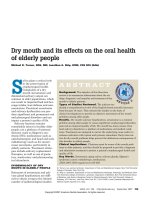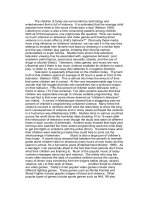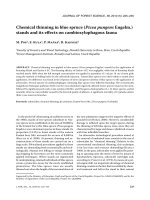Forest Fragmentation and its Effects on Biological Diversity: A Mapping Exercise
Bạn đang xem bản rút gọn của tài liệu. Xem và tải ngay bản đầy đủ của tài liệu tại đây (754.23 KB, 9 trang )
Forest Fragmentation and its Effects on Biological
Diversity: A Mapping Exercise
James P. Gibbs
SUNY-ESF, Syracuse, New York, 13210, USA
Reproduction of this material is authorized by the recipient institution for nonprofit/non-commercial educational use and distribution to students enrolled in
course work at the institution. Distribution may be made by photocopying or via
the institution's intranet restricted to enrolled students. Recipient agrees not to
make commercial use, such as, without limitation, in publications distributed by a
commercial publisher, without the prior express written consent of AMNH.
All reproduction or distribution must provide full citation of the original work and
provide a copyright notice as follows:
"Copyright 2006, by the authors of the material, with license for use granted to
the Center for Biodiversity and Conservation of the American Museum of Natural
History. All rights reserved."
This material is based on work supported by the National Science Foundation
under the Course, Curriculum and Laboratory Improvement program (NSF
0127506), and the United States Fish and Wildlife Service (Grant Agreement No.
98210-1-G017).
Any opinions, findings and conclusions, or recommendations expressed in this
material are those of the authors and do not necessarily reflect the views of the
American Museum of Natural History, the National Science Foundation, or the
United States Fish and Wildlife Service.
Forest Fragmentation and its Effects on Biological
Diversity: A Mapping Exercise
James P. Gibbs
GOALS
This exercise has two goals. The first is to permit you to explore through a
mapping exercise what happens to a forested landscape as it undergoes the
fragmentation process. The second is to let you predict what will happen to the
biota residing within the landscape as a result of these changes. The
fundamental question we address is: Can landscapes be fragmented in such a
way that permits humans and biological diversity to coexist?
OVERVIEW
The first part of the exercise involves measuring changes in a forested landscape
as it is fragmented. You begin with a blank grid that represents an undisturbed
landscape dominated by forest. Much of the forest is on the upland but some
also occurs in wetlands that are connected by streams that are themselves
surrounded by gallery forest. Both wetland forest and gallery forest are
considered “seasonally inundated forest” and are both indicated on the map by
wetland symbols.
Starting with the blank grid, you will mark grid squares in a progression that
mimics fragmentation of the landscape associated with colonization of it by
humans, first by adding a major road and the cleared lands associated with it,
and then adding secondary roads and tertiary roads and the cleared lands
associated with them. “Filled” grid squares will represent areas cleared of forest
and converted for agricultural purposes whereas “cross hatched” grid squares
will represent edge zones of remaining forest that is directly adjacent to cleared
areas. You will then repeat this fragmentation process while invoking some
simple land use guidelines to examine how they might influence the outcome in
terms of structure of the landscape and the biodiversity within it. You end up with
three landscapes to compare: (1) the original landscape, (2) the landscape
subjected to uncontrolled fragmentation, and (3) the landscape subject to
fragmentation guided by some simple land use regulations and alternatives.
The second part of the exercise enables you to predict what will happen to the
biota residing within the landscape as a result of its fragmentation. For each of
your mapped scenarios for the same landscape, you will calculate some key
biological parameters to make predictions about the state of biological diversity
and ecosystem function within the landscape. You will examine how changes in
the landscape affect (1) ecosystem diversity of the landscape, (2) species
diversity within the landscape, and (3) ecosystem function in terms of carbon
sequestration within the ecosystems present. Advanced students may also want
to attempt the remaining steps, which address: (4) population viability of a large
herding mammal, (5) foraging energetics of wide-ranging birds, and (6) effective
population size and genetic drift in a canopy tree. By contrasting these biological
indicators in the three landscapes you generate, you will get a good sense of
how fragmentation affects biodiversity and how we can mitigate some of the
negative effects of it through planning and incentives.
PART I: THE FOREST FRAGMENTATION PROCESS
BECOMING FAMILIAR WITH THE BASIC MAP
First, get oriented to the basic map by noting the cardinal directions. Which way
is north? South? East and west? Second, familiarize yourself with the map’s
scale. Each grid square is 100 m on a side. What is the area of each grid
square? What is the width and length of the study landscape? What is the total
area of the landscape (in ha and km2)? If you move horizontally from one grid
square to the next, what distance have you moved? If you moved diagonally,
how far have you moved? Now look at the different cover types. Can you
recognize the inundated (wetland and gallery) forests? The upland forests? The
streams and other watercourses?
Scenario I: The original landscape with natural small, scattered disturbances and
its human population
Scattered disturbances are typical even within the original, unfragmented
landscape. These might be due to lightning strikes that have created small
openings. Many of these may also have been created by humans who have
constructed small, shifting garden plots in certain areas or lit fires in others to
generate second growth and attract game. These disturbance patches usually
don’t comprise a large portion of the landscape (perhaps up to 2% of the area)
and are generally well dispersed. To mimic this situation, randomly choose 2% of
the grid squares and convert them to open habitats (filled grid squares) and
change the grid squares surrounding open habitats to edge habitats (crosshatched grid squares).
What is the human population being supported within the landscape? Assume
that each family (average of five people per family) needs exclusive access to 3
hectares of cleared land for cultivation to meet their needs or 50 hectares of
forestland (upland or inundated and not necessarily contiguous) for extraction of
natural products and hunting. Often people combine both cultivation and harvest
of wild products but we will consider a simple division of livelihoods in this case.
Scenario II: The landscape fragmented in an uncontrolled manner
Starting with a blank map of the original landscape, add a road dissecting the
region. This road might be the end result of exploration of a remote area for oil or
gas or the result of a government effort to access a frontier zone. To make this
road, simply draw a heavy line along an east-west axis through the middle of one
of the central rows of grid squares. The road width is negligible and can be
ignored but it provides immediate access to the grid squares traversed and those
immediately adjacent to them (150 m back from the road). These are converted
to agriculture. Therefore, fill in all traversed and adjacent grid squares - three
rows total.
Note that this initial dissection of the forest also changes the forest that is
adjacent to the converted lands into edge habitat. Consider that ecologically
important edge effects can extend at least 100 m into a stand, so cross-hatch all
the forested grid squares adjacent to cleared land to indicate where forest edge
has been created.
Now add more roads. These are the kinds of roads created by people who follow
the first major road and now seek to colonize the area and convert more of the
forest for agriculture and other uses. Add two such roads by drawing dark lines
perpendicular to the initial road that cross it at about 450 m and 1450 m along its
length. Extend the secondary roads in both directions right across the landscape.
Repeat the process of demarking converted lands 150 m from the roadsides and
then the edge habitats adjacent to them.
Calculate the human population supported within the landscape.
Scenario III. The landscape fragmented following some simple land use
guidelines
Starting with a clean map, add roads and cleared lands as you did in Scenario II,
with the objective of generating sufficient resources for a comparable number
people, but place the roads in any configuration you want that satisfies these
simple land use guidelines and land use alternatives (adapted in part from
Laurance and Gascon, 1997):
Triple the production rates on cultivated land through provision of fertilizer
and perhaps alternative crops so that local people now need to clear only
a third as much forest to meet their needs. Note that under the land use
alternatives scenario, however, each family can meet its needs on just one
hectare of cultivated land because productivity has been tripled. In other
words, now you only convert the lands up to 50 m from roadsides, so fill in
only the blocks directly intersected by the road.
Prohibit forest clearing of any habitat block that supports a watercourse.
Note that roads can traverse watercourses but the forest blocks that
include watercourses are not cleared.
Protect all rare ecosystems -- no conversion of inundated forests.
Allocate half of the landscape to production purposes and human use
while allocating the other half to reserve status.
Recalculate the human population supported within the landscape.
PART II: BIOLOGICAL IMPLICATIONS OF THE FRAGMENTATION
SCENARIOS
STEP 1. LANDSCAPE ANALYSIS AND ECOSYSTEM DIVERSITY
For each of the maps that you produce from the three fragmentation scenarios
above, tally the area of the landscape that is upland forest interior, upland forest
edge, inundated forest interior, inundated forest edge, and land converted from
forest to agriculture. Note that riparian zones of the watercourses are natural
“edges” or ecotones, but we are concerned here with forest edges adjacent to
open habitats. Calculate the fraction of the landscape composed of each habitat.
Last, estimate ecosystem diversity within each of these landscapes using the
Shannon-Weiner index of diversity, which is
-∑pi*log(pi),
where pi = the fraction of the landscape represented by ecosystemi. For example,
if interior forest occupied 900 of the total 1000 grid squares and inundated forest
occupied the rest of the landscape, then Simpson’s index of diversity would =
(0.9*log(0.9))+(0.1*log(0.1)). Your calculations will be similar but made across all
ecosystem types.
STEP 2: CHANGES IN ECOSYSTEM FUNCTION – CARBON SEQUESTRATION
Based on the estimates of Laurance et al. (1998) for Amazonian moist forest
near Manaus, Brazil, forest biomass averages 300 tons/ha with carbon
comprising 50% of that amount. Forest clearing commits 95% of forest biomass
to carbon emissions from burning and decay with 5% remaining as relict living
trees in pastures or inert as charcoal. Forest edges lose 10% of their biomass
mortality of trees is higher on the edges. Do not distinguish inundated from
upland forests for this exercise. Based on these relationships, estimate the tons
of carbon sequestered by the landscape in above-ground woody biomass under
the three different landscape scenarios.
STEP 3: CHANGES IN FAUNAL DIVERSITY
Estimate the faunal diversity of an average habitat block within the landscape
under the different scenarios of fragmentation (undisturbed, uncontrolled
fragmentation, fragmentation with some land use guidelines and alternatives).
This can be done with information on birds, mammals, frogs, and ants gathered
by Gascon et al. (1999). These researchers worked over several decades to
determine which species near Manaus, Brazil, primarily used forest interior,
forest edge, and “matrix” or open lands near fragments. Note that some of the
forest species listed below use the matrix but still rely on the primary forests.
Approximating from the Gascon et al. (1999) report (Figures 2 & 3), for birds
there are locally some 123 species, 31 of which use the matrix (converted lands)
versus 92 that use the forest edge and 92 that use forest interior. Note that no
birds were restricted to the forest interior, so the same 92 occur in both edge and
interior areas. For frogs, there are 62 species, 16 of which use only the matrix, 52
of which occur in the forest interior, and 51 of which use the forest edge. Of 15
mammals in the area, 4 use the matrix only, 15 use the forest interior, and 10 use
the forest edge. For the 127 ant species, 32 use the matrix only, 104 use the
primary forest, and 44 use the forest edge. Do not distinguish inundated from
upland forests for this exercise.
Now calculate the average diversity per hectare for each of these faunal groups.
To do so, for each landscape multiply the number of hectares of each habitat
type by the expected diversity within it. Next sum these values across habitat
types. Last, divide by the sum of the weights, which is the same as the total area
of the landscape. For example, if the landscape was composed of 1000 grid
squares, of which 500 were primary forest, 250 were forest edge, and 250 were
matrix, then ant diversity on average in that landscape would =
((500*104)+(250*44)+(250*32))/100. This “weighted average” will indicate how
many species are likely to occur, on average, per hectare in each landscape.
[Optional exercises for advanced students]
STEP 4: POPULATION VIABILITY OF A HERDING SPECIES WITH A LARGE
HOME-RANGE
Assume that one km2 of forest (interior and edge) can support five white-lipped
peccaries and that these animals live in herds (Fragoso, 1998) that roam in a
fairly predictable fashion about the landscape. Also assume that the peccaries
are reluctant to cross roads and cleared areas because they will be shot and
therefore restrict their movements to individual forest remnants. Therefore, forest
blocks support isolated populations.
What is the total peccary population among all the remaining viable populations?
To answer this, you will first have to tackle the following questions: How many
peccaries can each of the remaining forest patches support? What fraction of
patches contains both the upland and wetland forest that are required to meet
the annual needs of these animals during the wet and dry seasons? Note that if
both wetland and upland forest are not available within a forest patch, then a
population cannot be supported.
STEP 5: MOBILE SPECIES AND FORAGING ENERGETICS
Let's consider a wide-ranging, large-bodied frugivorous bird that must visit many
sites every day to harvest newly ripened fruit. A hornbill, quetzal, or large parrot
are good examples. Let's assume the tree species whose fruits it needs occur
only in inundated forests, that is, in the highly clumped distributions that are
typical of many tropical trees. How far must these birds travel on average each
day to meet their daily needs? Assume that a pair of these birds must visit five
such patches (one hectare blocks of inundated forest) each day.
To answer these questions, first trace the shortest path possible between all
patches of inundated forest in the landscape. Start with an isolated patch in one
of the corners of the landscape. It’s virtually impossible to find the exact shortest
path so just try to link all patches together as might a foraging bird that was trying
to save energy flying between all the patches. As you move to the next nearest
patch of inundated forest not yet visited, sum up the distance of each sequential
move. The total distance traveled divided by the total number of patches visited
equals the average cost of accessing a foraging site. Recall that the birds must
visit five patches per day to meet their needs.
STEP 6: GENETIC DIVERSITY IN A CANOPY TREE
Consider a rare tree species with mature individuals distributed evenly through
the upland forest at a density of only one per hectare. A good example is
Pithecellobium elegans (Chase et al., 1996; Hall et al., 1996). Any trees within
250 m of any other trees represent part of the same breeding population (can
exchange gene flow). More distant individuals are unable to exchange pollen
effectively and are therefore considered to be members of a different population.
First, mark the individuals linked through potential gene flow by drawing a line
that includes all collections of individuals within 500 m of another individual.
Next, assuming that the genetically effective population size in this species
equals the census population size (only breeding adults in this long-lived species
are considered), what average fraction of heterozygosity will be lost over the next
100 generations from each of the remaining breeding populations? Recall that
the formula for estimating the amount of genetic variation (heterozygosity) in a
population of size Ne retained after t generations =
[1 - (1/(2*Ne))]t
Repeat these calculations for each Pithecellobium elegans population under
each of the three landscape fragmentation scenarios. What is the least amount of
genetic diversity lost by any single population under each scenario?
PART III: SYNTHESIS
Construct a table that summarizes, for each of the three fragmentation scenarios,
the (1) human population supported in the landscape, (2) characteristics of the
landscape (fraction of land in different habitat types), (3) estimates for the key
biological indicators: fraction of land in different habitat types, ecosystem
diversity, carbon emissions from the landscape, average faunal diversity per
habitat block, population size and viability for white-lipped peccaries, foraging
energetics for the frugivorous bird, and genetic diversity in the tree
Pithecellobium elegans. To indicate how sensitive each parameter is to the
fragmentation process, calculate the proportional change in each parameter
relative to its value in the original landscape (Scenario I). Can you conclude that
biodiversity and substantial human populations can co-exist despite
fragmentation to the landscape? What social incentives and political means are
available to actually achieve a landscape like that in scenario III?
CITATIONS
Chase, M.R., C. Moller, R. Kessell, and K.S. Bawa. 1996. Distant gene flow in
tropical trees. Nature 383: 398-399.
Fragoso, JMV. 1998. Home Range and Movement Patterns of White-lipped
Peccary (Tayassu pecari) Herds in the Northern Brazilian Amazon.
Biotropica 30:458-469.
Gascon, C., T.E. Lovejoy, R.O. Bierregaard, Jr., J.R. Malcolm, P.C. Stouffer, H.L.
Vasconcelos, W.F. Laurance, B. Zimmerman, M. Tocher, and S. Borges.
1999. Matrix habitat and species richness in tropical forest remnants.
Biological Conservation 91: 223-229.
Hall, P., M.R. Chase, and K.S. Bawa. 1994. Low genetic variation but high
population differentiation in a common tropical forest tree species.
Conservation Biology 8:471-482.
Laurance, W.F. and C.Gascon. 1997. How to creatively fragment a landscape.
Conservation Biology 11:577-579.









